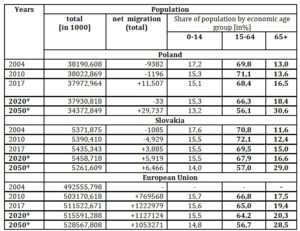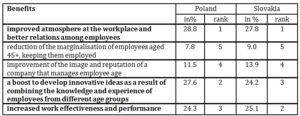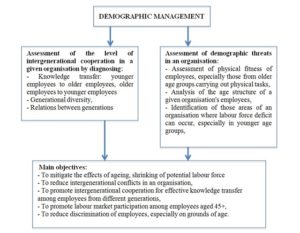Introduction
Carrying out an economic activity, today, involves functioning in an increasingly unstable environment, as an entrepreneur has to face both market risk, which is determined by macroeconomic as well as legal and political factors, and a specific risk, which is related to internal areas of the company’s activity (Sitek, 2015, Gorzeń – Mitka, 2016; Sipa, 2018, Korombel and Ławińska, 2018). Of particular importance are demographic factors. The demographic transformations occurring in European countries show clear changes in population age structure, and thereby in the size of potential labour force, with a decrease in the number of births and growing life expectancy (Hall, 2017; Ageing report, 2015) This, in turn, leads to an increasing process of population ageing. The consequences of such changes are difficult to overcome, especially given the current situation of enterprises. They face difficult tasks of recruiting the right employees while taking actions to address the growing share of older employees in the structure of the personnel. In view of the above, there is a growing need today to urgently develop a new approach to organisational, legal and economic issues as part of the management of human resources. This paper is a continuation of the author’s research into the impact of demographic processes on the socio-economic environment in selected EU countries (Skibiński, 2017). This time, the author’s attention was focused on an attempt to indicate the impact of current demographic trends on the functioning of an organisation as part of human resources management based on Eurostat data and results of a survey on management of intergenerational cooperation in an enterprise. The author of this publication is aware that the subject addressed does not fully cover the issues of the research undertaken in the context of the study of management, but due to the size constrains of the publication, he limited himself to selected issues.
Methodological Information
In order to illustrate demographic changes and their consequences for modern organisations, changes in the population age structure were presented for Poland and Slovakia based on a quantitative and qualitative analysis of data contained in Eurostat database. In the context of the research problem addressed in this publication, selected results of a survey were also presented showing respondents’ assessment of intergenerational cooperation in organisations. The survey was conducted among a population of university students (N=254) of part-time studies of the first and second degree in Poland and Slovakia in the period from March to April 2017. The method used was non-probabilistic sampling based on a diagnostic survey conducted on respondents gathered at one place and time. The research was empirical in nature, and the resulting findings refer to the surveyed population only and are not representative. They may, however, fill the gap in regional studies on demographic processes. Below are selected characteristics of the research sample.
Table 1: Selected characteristics of the surveyed population

Source: own work based on survey
Current and future demographic trends in EU countries: (Perspectives of Poland and Slovakia)
The phenomenon of population ageing is a modern demographic process that has never occurred before on such a scale and with such an intensity, and affects societies in Europe and other developed countries worldwide (Bloom et al., 2010; Rechel et al., 2013; Demographic projections for Poland and Slovakia for the next several decades are very unfavourable. These countries belong to a small group of EU countries where three phenomena with a significant impact on population demographic structure occurred. These are: fall in birth-rate below the replacement threshold, increased migration and increase in population median age. Analysing population ageing in this group of countries will help to look at the more distant future more responsibly. For that purpose, Eurostat demographic projections were used. Data showing significant demographic changes is presented in Table 2.
Table 2: Dynamics of the changes in the size and structure of population by economic age group in a selected group of EU countries

* prognostic data
Source own calculation based on: Eurostat database, http://ec.europa.eu/eurostat/data/database [access: 17.01.2019]
A few important conclusions can be drawn based on analysis of the data contained in Table 2. First, the population in Poland is projected to fall from 37. million in 2017 to 34,3 million in 2050. A similar downturn trend is projected for Slovakia (from 5,4 to 5,2 million), but with a markedly lower dynamics. This situation must be the result of the decreasing birth rate and low fertility rate as well as changes in net migration. In contrast, population growth is projected in the EU as a whole, as a result of, among other things, the impact of migration processes, also from countries outside of the EU. Second, the population age structure is changing. Poland and Slovakia see a clear increase in the share of post-working age population, while the shares of pre-working age and working age population are decreasing, which leads to population ageing, not only in the analysed group of countries but also within the EU. This has a clear impact on the labour market, as potential labour force is ageing and shrinking. In terms of the research problem addressed in this paper, it is worth looking at changes in population median age to estimate the rate of population ageing (Fig 1).

Fig. 1: Median age of population in Poland and Slovakia between 2010-2050.
Source: as in Table 2
The median age, which is one of the measures of ageing, shows that the process of structure deformation as a result of population ageing is very advanced within the EU. This means that half of the EU population was older than 42.8 in 2017 (in 2050, the median will increase by 3.9 years). Poland and Slovakia see a systematic growth in population median age. Within the next decades, based on projections data and current demographic trends, Poland and Slovakia will belong to a group of countries with the most ageing population. Thus, the data above confirms an overall ageing trend among Europeans, which in different countries is caused by different social, cultural and economic factors, and the awareness of the impact of population ageing on an organisation’s activity is and will be of fundamental importance for many enterprises, economies and employees themselves.
Human resources management in the context of demographic processes: Presentation of selected research findings
The term “human resources management” was introduced into theory and practice by Miles (1965) where the author indicated the need to look at people in an organisation in a comprehensive manner (as a resource) and use a systemic approach to the issue of personnel (Miles and Snow, 1984). Thus, this term should be understood as a set of an organisation’s activities that are aimed at recruitment, development and retention of effective labour force (Griffin and Moorhead, 2014). With dynamic changes occurring on the labour market as a result of population demographic ageing, among other things, there is a strong need to adjust activities in the area of human resources management (Strack et al., 2008). This has resulted in the emergence of two important concepts of human resources management, i.e. diversity management and age management. The first concept refers to diversity and differences across individual employees and prevention of situations when employees are discriminated on grounds of being different. The second concept involves undertaking certain activities and initiatives to rationally and effectively manage the human capital available in an organisation, including employees from older age groups, so that an individual’s work, regardless of their age, can bring profit to the organisation and satisfaction to the employee (Shen et al.,2009; Walker, 2009). In terms of consequences of current demographic trends for modern organisations, special attention should be paid to an organisation’s HR policy, as human resources managers face the challenge of generational diversity (Patrick and Kumar, 2012). At present, employees represent four generations: baby boomers (born between 1943 and 1960), generation X (1961-1981), generation Y (1982 -2002) and generation Z (born between 2003 and 2014) (Pendergas, 2009; Parry and Urwin, 2011). Each generation has different views, characteristics, interests, expectations and attitudes. Therefore, it seems important to monitor intergenerational cooperation in organisations. Such information can help to solve potential conflicts between employees from different generations. In view of the above, an attempt was made to assess intergenerational cooperation in the sector of small, medium-sized and large enterprises in Poland and Slovakia based on the opinions of the research population. First, information was obtained about the age of employees cooperating with one another (Fig 2).

Fig. 2: Average age of employees cooperating with one another [in %]
Source: own study based on survey.
The distribution of the respondents’ replies indicates that both in Poland and Slovakia, generation Y is the dominant group of employees. It is followed by employees from generation X and Z, respectively.
Thus, the results indicate generational diversity. The analysis of the survey results shows that despite the awareness of increasing population ageing, employers prefer employing people from younger age groups, which is confirmed by data contained in Fig 3.

Fig. 3: Preferable age of employees as indicated by respondents [in%]
Source: as in Fig 2.
The data in Fig. 3 indicates that the most preferred age of employees is between 26 and 35 years old, i.e. generation Y. This results partially from the fact that in countries of the former Eastern Bloc, such as Poland and Slovakia, age discrimination exists in organisations. This issue was defined in more details by Robert Butler as a set of views, prejudices and stereotypes rooted in biological variation among people, which refer to competencies and needs of individuals depending on their chronological age (Szukalski, 2009; Harris et al., 2018; Implict Ageism, 2018). A stereotypical attitude to employees from older age groups was also observed in the survey results. The respondents indicated that they encountered discrimination at their work place.

Fig. 4: Discrimination at the workplace as noticed by the research population [in%]
Source: as in above
The survey results show that over 86% of those surveyed in Slovakia encountered discrimination at their workplace. In Poland, this figure was much lower – 36.6%. Nevertheless, discrimination is still a common problem in organisations. Table 3 presents the most common forms of discrimination encountered by the respondents at their workplace.
Table 3: Forms of discrimination at the workplace that were most often indicated by the respondents

Source: own study based on survey
The distribution of the responses as presented in Table 3 confirms that the most common forms of discrimination as indicated by those surveyed are on grounds of age and possessed competencies and skills. They were followed by discrimination on grounds of gender and background. Thus, promoting intergenerational cooperation may contribute to elimination of discrimination regardless of its form. For that purpose, it seems important to create space for building and developing a dialogue between generations by combating negative stereotypes stating that employees from older age groups are less effective (Gerpott et al., 2017; Skibiński et al., 2016). This can be achieved, among other things, by increasing openness to diversity, developing communication competencies and promoting actions and creating working teams composed of employees representing different generations. In view of the above, the survey questionnaire contained a question about the benefits of intergenerational cooperation. The distribution of the responses is presented in Table 4.
Table 4: Benefits of intergenerational cooperation in terms of exchange of experience as perceived by the population surveyed

Source: as in Table 3
The above-presented data shows that both the respondents from Poland and Slovakia emphasise clear benefits of intergenerational cooperation, such as: improved atmosphere at the workplace and better relations among employees, a boost to develop innovative ideas as a result of combining the knowledge and experience of employees from different age groups and increased work effectiveness and performance. Thus, apart from strategic management of human resources, it is necessary to take into account demographic aspects, focused on actions aimed at mitigating the effects of labour shortages in different age groups by analysing the age structure of employees or managing multi-generational working teams. Moreover, development of tools for undertaking actions as part of the functioning of a specific organisation through:
– assessment of intergenerational cooperation in an organisation (knowledge transfer, younger employees to older employees, older employees to younger employees),
– assessment of demographic threats – decrease in productivity among older employees, especially in the case of physically demanding tasks,
– identification of those areas of the organisation where labour force deficit can occur – especially in younger age groups,
can help to mitigate the effects of population ageing, the consequences of which are already visible in the functioning of modern organisations. Figure 5 presents the concept of demographic management as an element of strategic management of human resources.

Fig. 5: Concept of demographic management as an element of strategic management of human resources.
Source: own study
Conclusion
Modern strategies of human resources management increasingly require that new concepts, such as age or variety management, are implemented into practice, as entrepreneurs no longer perceive human capital only in terms of increasing productivity and reducing labour costs. This is because human resources have begun to play a crucial role in creating an enterprise’s competitive advantage, both on the regional and international markets. Of key importance are knowledge, skills and ability to motivate employees who can be used by a given organisation. With the increasing process of population ageing, new concepts of management increasingly take into account the demographic aspect, as the changes in population age structure cannot be ignored. This is confirmed by the presented quantitative and qualitative analyses, which show a very fast progress in the process of population ageing, not only in Poland and Slovakia, but also in the entire European Union. Understanding the differences and similarities between generations will help to more effectively manage human capital, prevent the risk of conflicts among employees from different generations and eliminate discrimination at the workplace. Moreover, implementation of the concepts of demographic management may contribute to the mitigation of the effects of ageing and shrinking of potential labour resources.
(adsbygoogle = window.adsbygoogle || []).push({});
References
- Bloom, D. E., Canning, D.,Fink G. (2010)‘Implications of population ageing for economic growth,‘. Oxford Review of Economic Policy, 26(4), 583–612.
- European Commisson. (2015)‘The 2015 Ageing Report,‘ European Economy series 3217, 1–436
- Gerpott, F. H., Lehmann-Willenbrock, N., Voelpel S. C. (2017) ‘A phase model of intergenerational learning in organizations‘. Academy of Management Learning and Education, 16(2), 193–216.
- Gorzeń –Mitka, I. (2016)‘Leading Risk Management Determinants of Small and Medium-Sized Enterprises (SMEs)‘: An Exploratory Study in Poland. In: Bilgin M., Danis H. (ed) Entrepreneurship, Business and Economics – Vol. 1. Eurasian Studies in Business and Economics, vol 3/1. Springer, Cham, 289-298
- Griffin, R. W., & Moorhead, G., (2014)‘Organizational Behavior: Managing People and Organizations‘, South-Western, Mason, (11th), 46-59.
- Hall, D. R. (2017)‘Risk society and the second demographic transition,‘ [Online].Canadian Studies in Population, 29(2), 173. [Retrieved February 5, 2019], https://doi.org/10.25336/p6sc7k
- Harris, K., Krygsman, S., Waschenko, J., Laliberte Rudman, D. (2018)‘Ageism and the Older Worker: A Scoping Review‘, Gerontologist. Gerontological Society of America, pp. 1-14
- Implicit Ageism. (2018), In Ageism: Stereotyping and Prejudice against Older Persons. Nelson T.D. (ed) The MIT Press
- Korombel, A., Ławińska, O. (2018)‘Private Investments in European Union Countries – Polish Case,‘ Proceedings of the 4th International Conference on European Integration. ISBN 978-80-248-4169-4, 17-18 May 2018 , Ostrava, Czech Republic, 789-797.
- Miles, R. E.,Snow, C. C. (1984)‘Designing strategic human resources systems. Organizational Dynamics‘, 13(1), 36–52.
- Parry, E., Urwin, P. (2011)‘Generational Differences in Work Values: A Review of Theory and Evidence,‘ International Journal of Management Reviews 13, 79-96.
- Patrick, H. A., Kumar, V. R. (2012)‘Managing workplace diversity: Issues and challenges,‘ SAGE Open, 2(2), 1–15.
- Pendergast, D. (2009)‘Generational theory and home economics: Future proofing the profession,‘ Family and Consumer Sciences Research Journal, 37(4), 504–522.
- Rechel, B., Grundy, E., Robine, J. M., Cylus, J., MacKenbach, J. P., Knai, C., & McKee, M. (2013)“Ageing in the European Union. [Online] The Lancet. Lancet Publishing Group. [Retrieved January 26, 2019], https://doi.org/10.1016/S0140-6736(12)62087-X
- Shen, J., Chanda, A., D’Netto, B., & Monga, M. (2009)‘Managing diversity through human resource management: An international perspective and conceptual Framework,‘ International Journal of Human Resource Management, 235- 251.
- Sipa, M. (2018) ‘Innovation as a key factors of small business competition,‘ European Journal of Sustainable Development, 6(1), 244-356.
- Sitek, M. (2015) ‘Situation in the Polish housing market compared to other EU countries,‘ Journal of International Studies, 7(2), 57–69.
- Skibiński, A. (2017)‘The changes of the population structure and its consequences in selected eu countries – some aspects,‘ European Journal of Sustainable Development, 6(1), 357-368.
- Skibiński, A., Sipa, M., Gorzeń-Mitka, I. (2016)‘An Intergenerational Cooperation in the Organization – View from the Age Perspective,‘ Procedia – Social and Behavioral Sciences, 235, 412–419.
- Strack R., Baier J., Fahlander A.(2008)‘Managing Demographic Risk,‘ Harvard Business Review 86 (2),119-128.
- Szukalski, P. (2009)‘Ageizm -przejawy indywidualne i instytucjonalne,‘ Człowiek Dorosły i Starszy w Sytuacji Przemocy, 59–68.
- Walker, A. (2009)‘The Emergence of Age Management in Europe,‘ International Journal of Organisational Behaviour, 10(1), 685–697.
Notes
Diagnostic survey: The diagnostic survey method is a way of gathering knowledge about the structural and functional phenomena and dynamics of social phenomena, opinions and views of selected communities.
Median age: Measure showing the age that has not been reached by half of the population of a given society but which has been exceeded by the other half.











